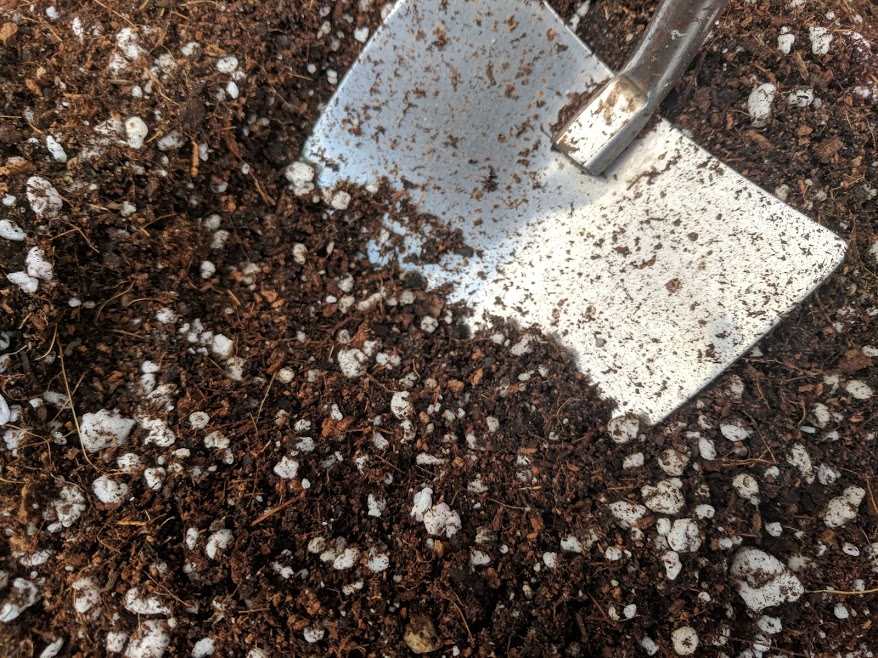As most potting soils don’t provide adequate water drainage or retention for Cannabis off-the-shelf, it’s essential to prepare a mix that will promote growth and optimize yield.
In this guide, we will walk through the basics of creating a compelling, versatile growing mix of common ingredients.
Requirements for a good soil
- Drains excess water well, but doesn’t dry out too quickly.
- Light and airy enough – compacted soil will stunt root growth.
- Maintains pH balance, and efficiently delivers nutrients.
To meet all of these requirements, we’ll start with commercial potting soil, then add coco-coir and perlite to improve drainage, nutrient delivery, and water retention.
There are commercial options that come premixed and ready to go, – we’ll cover some of these at the end of the article – but making your own is more cost effective and gives more control over your mixture, to best suit your needs.
Quick Soil Mix Guide
1) Add 40% Potting Soil
This is the ‘dirt’ part of the soil mix. Dirt is mostly organic matter, and good potting soil is made up of bark, composted forest humus, peat moss, perlite, and vermiculite to form a light, airy soil that will retain water and nutrients close to the roots. An excellent soil will contain earthworm castings, kelp meal, bone meal, guano, and other natural nutrients.
Top quality potting soils sometimes add mycorrhizal fungi, very beneficial organisms that colonize the roots and assist in the uptake of water and nutrients. This root colonization is especially essential if you are using organic nutrients. Mycorrhizal fungi are available at most gardening centers so that you can add it yourself.
If your potting soil comes with nutrients and fertilizers, keep this in mind when transplanting. If you are using Fox Farm’s Ocean Forest, for example, you won’t need to add any nutrients for the first few weeks.
Important: Don’t use Miracle Grow soil or any potting soil with time-release fertilizers. To optimize yield, you’ll need control of nutrient levels in your soil, (e.g., lowering nitrogen and raising phosphorus and potassium during flowering) but time-release fertilizers work on constant nutrient rates.
Use about 40% potting soil in your mix.
2) Add 40% Coco Coir
Coco coir is produced from the fibers of coconut husks, making it incredibly convenient and renewable. It functions as a fantastic retainer of water and lightens the consistency of the soil. Adding it to your mix will create an optimal environment for your Cannabis roots to grow. Coco coir is an inert ingredient; it does not contain any nutrients.
Coco coir is available in bricks or loose forms. Since it naturally contains a lot of sodium, look for products that have been washed to remove the sodium: also consider using a calcium supplement, (like Cal-Mag) as Cannabis grown with coco coir seem to need increased calcium levels.
Coco coir takes the place of peat in traditional mixes. Peat is sufficient but not easily renewable, so it comes with an environmental cost. Use about 40% coco coir in your mix.
3) Add 20% Perlite
Perlite is a volcanic glass that increases water drainage and lightens the soil to provide more air to the roots. Although commercial mixes often already contain perlite or pumice, Cannabis will benefit from additional drainage and aeration.
Use about 20% perlite in your mix.
4) Mix it!
That’s all. Three simple ingredients make up the perfect recipe for a healthy cannabis soil.
What about premix?
If you’re looking for a premix that’s optimized specifically for cannabis, several options have been designed by experts specifically for marijuana. We have tested several and found them to be extremely useful mediums.
What about organic enrichments?
Enriching your soil with additional amendments is a great idea and will help your plant reach its full potential.
Worm Castings – A mixture of active bacteria, enzymes, and animal waste, worm castings are excellent organic fertilizers. They are high in nitrogen, phosphorous, potassium and calcium as well as iron, copper and other micro-nutrients. Worm castings are water soluble, so nutrients are immediately available to the plant but won’t burn plants. Mix worm castings directly into the soil. As a bonus, worm castings also improve the texture and drainage of the soil.
Mycorrhizal Fungi – ‘Mycorrhiza’ describes a symbiotic relationship between fungus and plant roots – where the fungi get access to water and carbs, and in return, they enable the plants to more efficiently uptake water and nutrients. Adding mycorrhizal fungi to your mix can significantly improve growth rate.
Bat Guano – This is bat fecal matter, and it has been used as an organic fertilizer for centuries. Guano is an excellent source of NPK. You can spread it on the top layer, work into the soil or make a compost tea with it. As a bonus, bat guano also improves the texture and drainage of the soil.
To learn more about organic cannabis farming, read our guide to organic cannabis gardens.
Alternatives to Coco Coir?
Coco takes the place of peat moss in traditional soils but can be more challenging to find.
Peat Moss – Peat moss is very commonly used to lighten soils and improve water retention. The problem with peat moss is that it takes many thousands of years to replace, so comes with an environmental cost.
Rice Husks – Rice husks lighten the soil and improve water retention. Since they are the by-product of processing rice, they are a renewable and economical medium.
